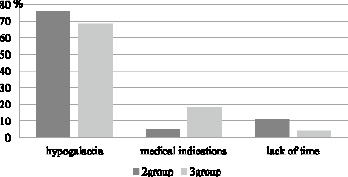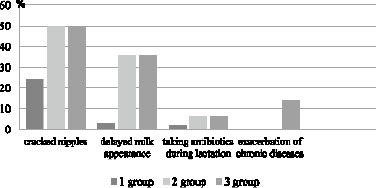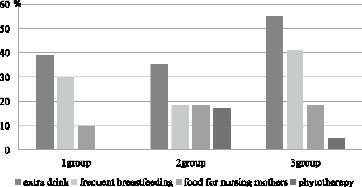Age appropriate nutrition of children in the first year of life ensures normal morphological and functional maturation of the child’s internal organs, as well as harmonious physical and neuropsychological development [1, 2, 3]. The special importance of the nutritional factor in infancy is due to the rapid processes of growth and development of the child, the formation and development of the structure of organs and systems and the improvement of their functions [4, 5].
It is known that only mother’s milk is the best nutrition, optimal for a baby of 1 year of life, created by nature itself in the course of thousands of years of evolution. It is the only type of food that is fully adapted to the limited possibilities of the infant’s digestive functions and other systems [6, 7]. Globally, only about 35 % of children below than 6 months of age are exclusively breastfed [7]. According to the Federal State Statistics Service of the Ministry of Health of Russia (2019), breastfeeding among children from 3 to 6 months. amounted to 43.2 %, from 6 to 12 months – to 40.4 %. [5]. These data indicate that the problem of breastfeeding has not only medical but also social significance.
With the clear and proven benefits of breastfeeding for both the baby and the mother, healthcare providers continue to fight to improve breastfeeding rates. According to the literature, one of the most common reasons for refusing breastfeeding is the lack of breast milk [8, 9].
Hypogalactia is a decrease in the functions of the mammary glands, which can manifest itself in a violation of the processes of lactopoesis, lactogenesis or milk flow, as well as in a reduction in lactation in time (less than 5 months) [10].
According to the conclusion of WHO experts, hypogalactia is one of the most complex problems, which covers not only biomedical, but also social issues. Its frequency ranges from 6.4 to 30 % of cases among all breastfeeding mothers [11]. As an independent violation of lactation, hypogalactia is the reason for the transfer of up to 30 % of children to artificial feeding [10].
The physiological manifestations of a decrease in lactation include lactation crises, which are manifested in a temporary decrease in the amount of milk produced by a woman. This is due to periodic physiological rises and decreases in the level of hormones in the woman’s blood. Lactation crises more often occur at 3–6 weeks, 3–4 months, and 7–8 months of breastfeeding [9].
So, the issues related to the prevalence of hypogalactia, the reasons for its development and measures to overcome it remain relevant.
Aim. To study the reasons for transferring a child to artificial and mixed feeding, methods for increasing lactation used by mothers in the Central Federal District.
Materials and research methods
The research was carried out by interviewing mothers in an online form using the survio.com service and analyzing medical records (outpatient child development card, form 112 / y). Data collection included a detailed assessment of infant feeding in the first year of life.
The study involved 106 mothers and their children from the cities of Smolensk. Bryansk, Kaluga and Moscow. The average age of mothers was 25.2 ± 1.98 years, and their children – 1.09 ± 0.37 years.
According to the results of the survey, the respondents were divided into three groups:
– Group 1 consisted of mothers and their children who are breastfed (HB) up to 1 year (63 mother-child pairs);
– Group 2 – women and their children who are bottle-fed (IV) (19 mother-child pairs);
– Group 3 – mothers and their children on mixed feeding (SV) (24 mother-child pairs).
Statistical processing of the obtained data was carried out using the standard package of statistical programs Microsoft Excel 2016, Statistica 2016. The Pison test (χ2) and Student’s t-test for independent variables were used for statistical evaluation of the level of validity of the difference in the values of the parameters in the groups. The Fisher’s test in the package for statistical data processing (Fisher’s Exact Test) was used to test the statistical hypothesis about the average value and the calculation of the confidence interval. The differences were considered significant at p < 0.05.
Research results and discussion
As a result of the study, we found that in the Federal Central District 59 % of children were breastfed up to 1-year-old, artificial – 18 %, mixed feeding – 23 % of children.
In general, in the Russian Federation in 2018, the number of children who are breastfed from 6 months to 1 year is 40.3 % (table) [12].
Prevalence of breastfeeding in children of 1 year of age in the Russian Federation
|
The number of children who were breastfed |
2005 |
2010 |
2015 |
2016 |
2017 |
2018 |
|
At the age of 3-6 months Thousand people |
544,7 |
647,9 |
750,9 |
757,8 |
737,1 |
690,4 |
|
At the age of 3-6 months as a percentage of the number of children who reached 1 year in the reported year |
40,1 |
39,9 |
42,5 |
43,4 |
43,2 |
44,4 |
|
from 6 months to 1 year thousand people |
487,5 |
655,5 |
708,1 |
719,3 |
689,4 |
627,2 |
|
from 6 months to 1 year as a percentage of the number of children who reached 1 year in the reported year |
35,9 |
40,4 |
40,1 |
41,2 |
40,4 |
40,3 |
The main reasons for the transfer of a child from breastfeeding to artificial or mixed feeding were: hypogalactia in 76 % of mothers in group 2 and in 68 % of women in group 3 (p > 0.05), the need to take antibiotics due to exacerbation of chronic diseases in 5 % of group 2 and 18 % of group 3 (p < 0.05), lack of time to breastfeed – in 11 % of group 2 and 4 % of group 3 (p < 0.05) (Fig. 1).

Fig. 1. Reasons for transferring a child to artificial or mixed feeding
It was revealed that primary hypogalactia was observed in 9 % of women whose children were artificially fed. All women with primary hypogalactia had endocrine system pathology (infantilism, diabetes mellitus, or diffuse toxic goiter). Secondary hypogalactia among respondents from groups 2 and 3 was by 7 times more common – in 67 % (p < 0.05), which indicates the urgency of the problem of maintaining lactation in the modern world and is consistent with the literature [6, 7, 8].
In 49 % of lactating women whose children were breastfed up to 1-year-old, lactation crises were observed, which occurred at 3 weeks, 3, 4 and 7 months of lactation.
The study found that 51 % of mothers of group 1 experienced difficulties in breastfeeding only after childbirth as a result of incorrect position of the baby at the breast (“propeller” syndrome) and improper grip of the nipple – the baby was “hanging on the nipple”, as well as intermittent feeding compared with mothers of groups 2 and 3, who had no difficulty in breastfeeding only in 8 % of cases (p < 0.05).
Analysis of the data obtained showed that the most common difficulties in breastfeeding that became the causes of hypogalactia (Fig. 2) were nipple cracks in 1/2 mothers of groups 2 and 3 and in ¼ mothers of group 1, resulting from a violation of the technique of attaching the baby to the mother’s breast. Late first attachment of the child to the breast (on day 2) was detected in 3 % of women in group 1 and in 36 % in groups 2 and 3 (p < 0.05). Rare attachment of the baby to the breast, long breaks between feedings as a result of taking antibiotics during lactation were detected in anamnesis in 2 % of cases in mothers of group 1 and in 6 % of cases of women in groups 2 and 3 (p > 0.05). Violation of the feeding regimen as a result of acute (ARVI, influenza) or exacerbation of chronic diseases of the mother caused hypogalactia in 14 % of mothers of group 3 (p > 0.05).

Fig. 2. Causes of hypogalactia

Fig. 3. Methods used to increase lactation in hypogalactia
“Sluggish sucking”, which leads to insufficient irritation of the receptors of the mammary gland and inhibition of lactation was detected in 9 % of breastfed children, 23 % of mixed-fed children and 19 % of children transferred to artificial feeding (p < 0.05). Stomatitis, thrush was observed in 3 % of children in group 2 and 10 % in group 3 (p > 0.05).
It was found during the analysis of the survey data that the most frequently used way to increase the lactation was the increase in the volume of fluid consumed (additional drinking in the amount of 1 liter per day), including the use of lactogonous teas (Babushkino Lukoshko, Laktafitol, Laktogon, “Lactavit”, “Lactamama”, “Mother’s tea”, “Milky Way”, “Hipp”), in 39 % of mothers in group 1, 35 % in group 2 and 55 % of women in group 3 (p < 0.05) (Fig. 3).
An increase in lactation after more frequent breastfeeding was observed in 30 % of lactating women whose children were breastfed, 18 % and 41 % of mothers whose children were transferred to artificial and mixed feeding (groups 2 and 3, respectively) (p < 0, 05).
Specially developed protein-vitamin nutrition for nursing mothers in order to increase lactation (Lactamil, Femilak, BellaktMama, Mom and Me) was used by 10 % of mothers in group 1 and 18 % of women in groups 2 and 3 (Fig. 3).
In the first group an increase in the volume of fluid intake, the use of lactogonic teas, additional nutrition for nursing mothers and more frequent latching of the baby to the breast was in almost 100 % of cases sufficient to overcome lactation crises.
Herbal medicine in the form of decoctions and infusions from plants with lactogonic properties (stinging nettle leaves, caraway seeds, fennel and anise fruits containing anethole, which increases prolactin due to competition with dopamine for receptors) was used only by 17 % of mothers in group 2 and 5 % of mothers 3 groups, the rest considered this method of treating hypogalactia outdated, time-consuming and ineffective (p < 0.05).
Physiotherapy for the breast with Bioptron (Zeptor, Switzerland, based on the use of polarized light), ultrasound, electromagnetic vibration massage of the mammary gland) contributed to an increase in lactation in 12 % of mothers whose children were on mixed feeding.
Drug therapy in the treatment of hypogalactia, which included taking the drug “Apilak”, vitamin E, nicotinic acid, homeopathic drug “Mlekoin”, was prescribed to only 5 % of mothers of group 3.
Almost all women who kept breastfeeding for up to 1 year (group 1) in 98.6 % passed the “School of expectant mothers” in the antenatal clinic and the “School for young mothers” (in the children’s polyclinic). At the same time, mothers whose children were transferred to mixed or artificial feeding (in 79.3 %) either completely ignored these schools and did not go to classes or did not go regularly. They in contradistinction to mothers, who kept lactation for a long time, did not believe that the child’s contact with the mother, mother with the baby stay and “free feeding”, when the frequency and duration of feeding is determined by the newborns are important for the prevention of hypogalactia and the formation of lactation. Feeding on demand – the main factor in the prevention of hypogalactia was considered in 99.2 % of women in group 1, 64.3 % and 34.7 % of mothers in groups 2 and 3, respectively (p < 0.05).
Conclusions
So, one of the main reasons for transferring a child to mixed and artificial feeding is hypogalactia. In most cases, nursing mothers have secondary hypogalactia.
The most common reasons of hypogalactia are cracked nipples, late first attachment to the breast, long breaks between feeds as a result of the mother’s medication and “sluggish suckling”, when the baby is latching on to the breast.
The most common methods of combating hypogalactia are the use of additional drinks by lactating women, including lactogone teas, special food for nursing mothers and more frequent latching of the baby to the breast. Drug therapy for the treatment of hypogalactia is rare.
For a sufficient production of breast milk, it is advisable to practice early first attachment of the baby to the breast, feeding the baby on demand; to increase lactation, it is necessary to use additional drinks in the form of lactogonous teas and specialized products for lactating women. For the treatment of hypogalactia, it is necessary to use medications more often.
Helping mothers to maintain natural feeding is one of the most important tasks of a pediatrician.
Библиографическая ссылка
Shtykova O.N., Legonkova T.I., Bobrick M.N., Kuzmenok E.A., Budina D.V. RESULTS OF A MULTICENTER STUDY OF THE REASONS FOR THE TRANSFER OF 1-YEAR-OLD CHILDREN FROM BREASTFEEDING TO OTHER TYPES OF NUTRITION // European Journal of Natural History. 2021. № 1. С. 38-42;URL: https://world-science.ru/ru/article/view?id=34147 (дата обращения: 14.12.2025).

